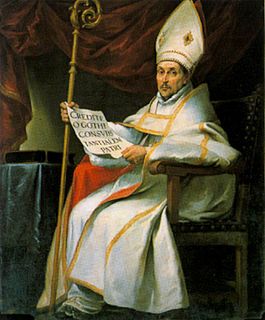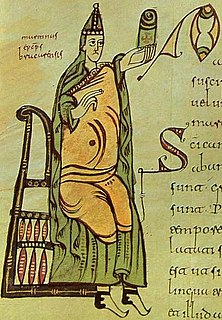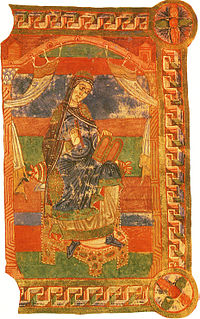 W
WQuintus Aurelius Memmius Symmachus was a 6th-century Roman aristocrat, an historian and a supporter of Nicene Orthodoxy. He was a patron of secular learning, and became the consul for the year 485. He supported Pope Symmachus in the schism over the Popes' election, and was executed with his son-in-law Boethius after being charged with treason.
 W
WAlcimus Ecdicius Avitus was a Latin poet and bishop of Vienne in Gaul. His fame rests in part on his poetry, but also on the role he played as secretary for the Burgundian kings.
 W
WBenedict of Nursia is a Christian saint venerated in the Catholic Church, the Eastern Orthodox Church, the Oriental Orthodox Churches, the Anglican Communion and Old Catholic Churches. He is a patron saint of Europe.
 W
WAnicius Manlius Severinus Boëthius, commonly called Boethius, was a Roman senator, consul, magister officiorum, and philosopher of the early 6th century. He was born about a year after Odoacer deposed the last Western Roman Emperor and declared himself King of Italy. Boethius entered public service under Ostrogothic King Theodoric the Great, who later imprisoned and executed him in 524 on charges of conspiracy to overthrow him. While jailed, Boethius composed his Consolation of Philosophy, a philosophical treatise on fortune, death, and other issues, which became one of the most popular and influential works of the Middle Ages. As the author of numerous handbooks and translator of Plato and Aristotle, he became the main intermediary between Classical antiquity and following centuries.
 W
WCaesarius of Arles, sometimes called "of Chalon" from his birthplace Chalon-sur-Saône, was the foremost ecclesiastic of his generation in Merovingian Gaul. Caesarius is considered to be of the last generation of church leaders of Gaul that worked to promote large-scale ascetic elements into the Western Christian tradition. William E. Klingshirn's study of Caesarius depicts Caesarius as having the reputation of a "popular preacher of great fervour and enduring influence". Among those who exercised the greatest influence on Caesarius were Augustine of Hippo, Julianus Pomerius, and John Cassian.
 W
WFlavius Magnus Aurelius Cassiodorus Senator, commonly known as Cassiodorus, was a Roman statesman, renowned scholar of antiquity, and writer serving in the administration of Theodoric the Great, king of the Ostrogoths. Senator was part of his surname, not his rank. He also founded a monastery, Vivarium, where he spent the last years of his life.
 W
WThe Collectio canonum Quesnelliana is a vast collection of canonical and doctrinal documents prepared (probably) in Rome sometime between 494 and (probably) 610. It was first identified by Pierre Pithou and first edited by Pasquier Quesnel in 1675, whence it takes its modern name. The standard edition used today is that prepared by Girolamo and Pietro Ballerini in 1757.
 W
WColumba was an Irish abbot and missionary evangelist credited with spreading Christianity in what is today Scotland at the start of the Hiberno-Scottish mission. He founded the important abbey on Iona, which became a dominant religious and political institution in the region for centuries. He is the patron saint of Derry. He was highly regarded by both the Gaels of Dál Riata and the Picts, and is remembered today as a Catholic saint and one of the Twelve Apostles of Ireland. In Ireland, he is commonly known as Colmcille.
 W
WColumbanus was an Irish missionary notable for founding a number of monasteries after 590 in the Frankish and Lombard kingdoms, most notably Luxeuil Abbey in present-day France and Bobbio Abbey in present-day Italy.
 W
WDionysius Exiguus was a 6th-century monk born in Scythia Minor. He was a member of a community of Scythian monks concentrated in Tomis, the major city of Scythia Minor. Dionysius is best known as the inventor of Anno Domini (AD) dating, which is used to number the years of both the Gregorian calendar and the (Christianised) Julian calendar. Almost all churches adopted his computus for the dates of Easter.
 W
WFinnian of Movilla was an Irish Christian missionary. His feast day is 10 September.
 W
WSaint Fulgentius of Ruspe was bishop of the city of Ruspe, Roman province of Africa, North Africa, in modern day Tunisia, during the 5th and 6th century. He was also canonized as a Christian saint.
 W
WGermain was the bishop of Paris and is a saint of the Eastern Orthodox Church and the Catholic Church. According to an early biography, he was known as Germain d'Autun, rendered in modern times as the "Father of the Poor".
 W
WGildas — also known as Gildas the Wise or Gildas Sapiens — was a 6th-century British monk best known for his scathing religious polemic De Excidio et Conquestu Britanniae, which recounts the history of the Britons before and during the coming of the Saxons. He is one of the best-documented figures of the Christian church in the British Isles during the sub-Roman period, and was renowned for his Biblical knowledge and literary style. In his later life, he emigrated to Brittany where he founded a monastery known as St Gildas de Rhuys.
 W
WPope Gregory I, commonly known as Saint Gregory the Great, was the bishop of Rome from 3 September 590 to his death. He is known for instigating the first recorded large-scale mission from Rome, the Gregorian Mission, to convert the then-pagan Anglo-Saxons in England to Christianity. Gregory is also well known for his writings, which were more prolific than those of any of his predecessors as pope. The epithet Saint Gregory the Dialogist has been attached to him in Eastern Christianity because of his Dialogues. English translations of Eastern texts sometimes list him as Gregory "Dialogos", or the Anglo-Latinate equivalent "Dialogus".
 W
WGregory of Tours was a Gallo-Roman historian and Bishop of Tours, which made him a leading prelate of the area that had been previously referred to as Gaul by the Romans. He was born Georgius Florentius and later added the name Gregorius in honour of his maternal great-grandfather. He is the primary contemporary source for Merovingian history. His most notable work was his Decem Libri Historiarum, better known as the Historia Francorum, a title that later chroniclers gave to it, but he is also known for his accounts of the miracles of saints, especially four books of the miracles of Martin of Tours. St. Martin's tomb was a major pilgrimage destination in the 6th century, and St. Gregory's writings had the practical effect of promoting this highly organized devotion.
 W
WIsidore of Seville was a scholar and, for over three decades, Archbishop of Seville. He is widely regarded, in the oft-quoted words of the 19th-century historian Montalembert, as "the last scholar of the ancient world".
 W
WJordanes, also written as Jordanis or Jornandes, was a Gothic 6th-century Eastern Roman bureaucrat who became a historian later in life. Jordanes wrote Romana, about the history of Rome, but his best-known work is his Getica, which was written in Constantinople about 551 AD. Along with Isidore of Seville's Historia Gothorum, it is one of only two extant ancient works dealing with the early history of the Goths.
 W
WSaint Leander of Seville was the Catholic Bishop of Seville. He was instrumental in effecting the conversion of the Visigothic kings Hermengild and Reccared to Catholicism. His brother was the encyclopedist St. Isidore of Seville.
 W
WSaint Martin of Braga was an archbishop of Bracara Augusta in Gallaecia, a missionary, a monastic founder, and an ecclesiastical author. According to his contemporary, the historian Gregory of Tours, Martin was plenus virtutibus and in tantum se litteris imbuit ut nulli secundus sui temporis haberetur. He was canonized in the Roman Catholic Church and Eastern Orthodox Church for his work in converting the inhabitants of Gallaecia to Chalcedonian Christianity, and his feast day is 20 March.
 W
WMaximianus of Ravenna, or Maximian was bishop of Ravenna in Italy. Ravenna was then the capital of the Byzantine Empire's territories in Italy, and Maximianus's role may have included secular political functions.
 W
WMo Sinu moccu Min, also known as Sinilis, Sinlán Moccu Mín was an Irish scholar.
 W
WSaint Nebridius was bishop of Egara (Terrassa) (516–527) and then bishop of Barcelona from 540 to around 547 AD. His feast day falls on 9 February. A native of Girona, Nebridius, according to tradition, had three brothers who were also saints. They were Saint Justus, bishop of Urgell; Saint Elpidius; and Saint Justinian. He was very learned and wrote interpretations of the Scriptures. He also wrote a work called In cantica canticorum about the church chants. He was a Benedictine.
 W
WSaint Nicetius was a bishop of Trier, born in the latter part of the fifth century, exact date unknown; died in 563 or more probably 566.
 W
WPaterius was a bishop of Brescia. He is known as a compiler, in particular of works of Pope Gregory I, for whom he worked as a notary.
 W
WPriscianus Caesariensis, commonly known as Priscian, was a Latin grammarian and the author of the Institutes of Grammar, which was the standard textbook for the study of Latin during the Middle Ages. It also provided the raw material for the field of speculative grammar.
 W
WRadegund was a Thuringian princess and Frankish queen, who founded the Abbey of the Holy Cross at Poitiers. She is the patron saint of several churches in France and England and of Jesus College, Cambridge.
 W
WSaint Remigius, French: Remi, Rémi or Rémy, was the Bishop of Reims and "Apostle of the Franks". On 25 December 496 he baptised Clovis I, King of the Franks. This baptism, leading to the conversion of the entire Frankish people to Christianity, was a momentous success for the Church and a seminal event in European history.
 W
WTribonian was a notable Byzantine jurist and advisor, who during the reign of the Emperor Justinian I, supervised the revision of the legal code of the Byzantine Empire.
 W
WVenantius Honorius Clementianus Fortunatus was a Latin poet and hymnographer in the Merovingian Court, and a Bishop of the Early Church. He has been venerated as Saint Venantius Fortunatus since the Middle Ages.